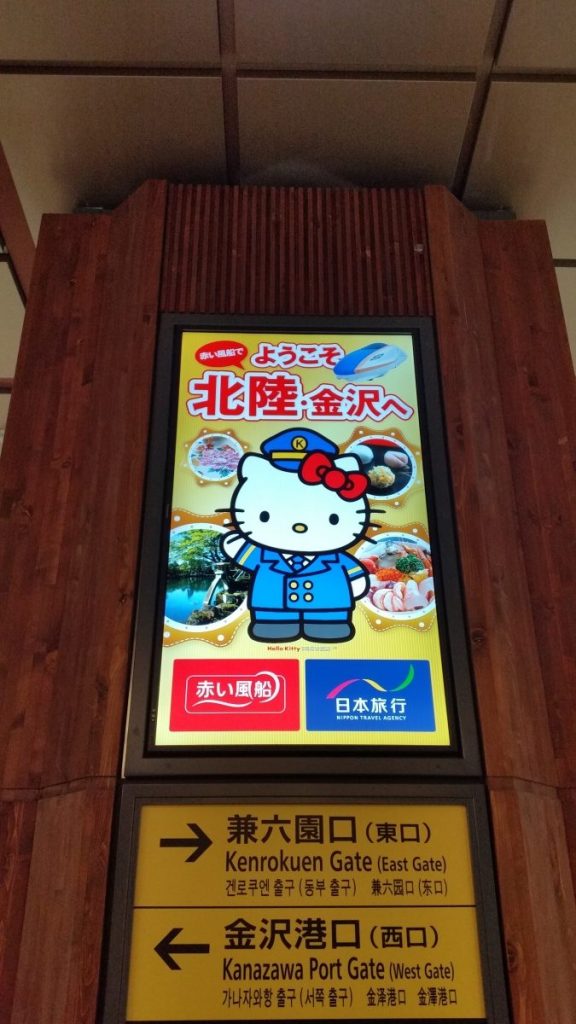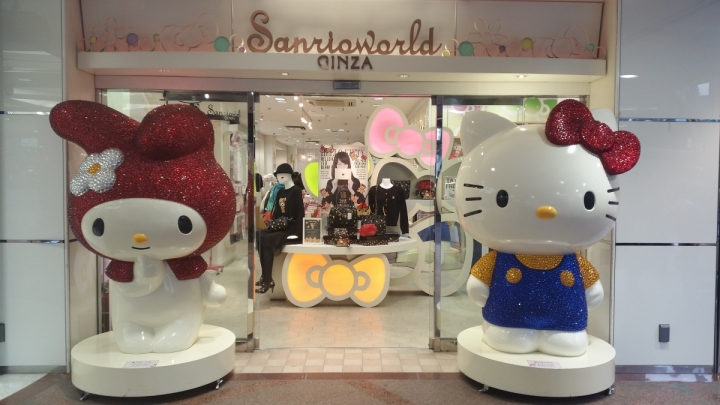Japan’s Kawaii Icon
I visited Japan and was instantly seduced. I was charmed by its courteous people, attention to visual design and clean, safe streets.
I also read about a nursing home attendant who deliberately broke her charges’ legs. I learnt about its violent, misogynistic hentai anime and unsavoury rorikon schoolgirl fetishes.
Japan seemed composed of impenetrable layers of contradiction. Sweetness and light with dark undercurrents.
How do you unravel an intricate kimono? You can start with Japan’s surface, smothered in kawaii culture. “Kawaii” means cute and adorable graphics are everywhere. The Queen of Kawaii is of course, Hello Kitty.

I’m a fan, so imagine my joy when I stumbled on the Tokyo flagship store five minutes from my hotel! At around 8 p.m. all the customers were adult women, mainly Japanese businesswomen. I floated through two pastel pink floors of merchandise heaven—a no-judgement zone spun from fairy floss.

Items ranged from stickers and pens to golf clubs, snowboards and diamond jewellery. Hello Kitty can leap from kindergarten to high-end fashion, entertainment and international relations. Designers clamour to work with her, Lady Gaga and Cameron Diaz have donned her in public and she was a United Nations UNICEF ambassador for children. Don’t be fooled by her doughy body and vacant expression; she is a sinuous economic tiger backed by a crack marketing team.

With minimal advertising, she rings in the bulk of the Sanrio character goods company’s turnover—$6.5 billion in licensing retail sales in 2014. She features on thousands of everyday products and her global army of devotees promote her every time she swings from a handbag or flashes from a mobile phone.

Her fame inspires cultish blogs. I’ve seen two bloggers post, “We are crazy but we are harmless!” A defensive appeal against the stigma attached to adults coveting childish goods. Kitty’s saccharine qualities can spark fear and derision. Men joke they should be wary of women who own too many cats. My Kitty souvenirs are man-repelling totems, peppered through my home, proudly on shelves or lurking in cupboards.
The birth of a kawaii superstar
Why do the Japanese embrace kawaii? Sanrio introduced Hello Kitty on a vinyl purse in 1974. She was an immediate hit with little girls. Then women caught Kitty fever. Kawaii consumerism grew alongside the affluent eighties bubble economy. Perhaps cartoons offer a form of rebellion in a country known for conformity, rigid social norms and punishing school and work schedules.
In 1970s England, the punk movement exploded in bile and spittle. In Japan, defiance was expressed as a polite refusal to grow up. Childhood represents fun and no responsibilities. Comforting images evoke warmth, personalise cold, hard technology, and form emotional cocoons in tough urban environments.


Kitty’s popularity crossed easily into other Asian markets. 2000 was the year of the Hello Kitty Singapore riots. A toy promotion with McDonalds triggered queue-jumping, fist fights, threats to store managers and vandalism. Three people went to hospital for cuts from broken glass.
The Deputy Prime Minister Lee Hsien Loong addressed the nation in a plea for calm. “Once in awhile is alright, but we should not get too carried away. Even if you want the Kitty, there is no need to fight fiercely to try and get one.” (Straits Times, February 2000)
This blip in Singapore’s stately, law-abiding national psyche still reverberates. The Wall Street Journal commemorated this lapse into mass hysteria.
In Taiwan, women can book into a Hello Kitty hospital maternity ward. Branded decor including furniture, blankets and nurse uniforms create a soothing space to ease the stress of childbirth.
Hong Kong has a Hello Kitty themed dim sum restaurant.
Hello Kitty’s path to world domination
In response to the 1990s recession, in 2002, the Japanese government developed the Cool Japan campaign to export innovative, youth-focused commodities like manga, anime, video games and kawaii around the globe. Today, Sanrio also has headquarters in Europe, North and South America.
I imagine a giant Hello Kitty emerging from the ocean like a Godzilla plushie, plodding amiably to the nearest metropolis, tubby arms open in benevolence. Who can begrudge Sanrio’s spoils? They’re not a drug cartel; they deal in “Friendship and Happiness.”

Some people question why Kitty has no mouth and view her as a racist stereotype of a mute, submissive Japanese woman, but I disagree. I once thought my obsession might be an Asian affliction. Perhaps it signified repression or attachment issues.
But as I see Western continents fall to Kitty, I realise her power lies in her ability to tap into universal impulses. Her plump limbs and huge bobblehead mimic a toddler’s proportions. This cuddly squishiness simply begs for a hug. She elicits our nurturing instincts and this disarming charm is the key to her expanding empire.

Internet users worldwide spend hours cooing over cat and dog photos and videos. An online stroll through craft superstore Etsy reveals an overpopulated forest of owls and foxes. The kawaii craze is viral. Cute translates into cash in any language.
Kitty turns 40 this year and themed passenger jets are flying from Taiwan to Paris and Singapore for the anniversary. Rule the skies, rule the world. The Japanese government wasn’t kidding when they promoted her as tourism official to Hong Kong and China in 2008.
Understanding kawaii is like peeling the thin outer skin of an onion, but in one aspect, Japan doesn’t feel as foreign as before. Hello Kitty, ever the gracious host, helped forge this bridge for me. Happy birthday dear feline friend.
For a large range of Hello Kitty goods visit the Sanrio flagship store: Sanrioworld GINZA, 1st Floor, 2nd Floor, Nishi Ginza Department Store,
4-1 Saki, Ginza, Chuo-ku, Tokyo,
JR : Yurakucho Station. Tokyo Metro : Ginza Station

Hello Kitty also has her own theme park in outer Tokyo (with a huge gift shop): Sanrio Puroland
Source: Yano, C., Pink Globalisation—Hello Kitty’s Trek Across the Pacific, Duke University Press, 2013

How does anyone get connected to these Hello Kitty links ? I’m a Big Hello Kitty fan, if you can help, please & thank you !
BobbieBabbette
LikeLike
Hi! I usually google for the latest stories. You might also like this funny blog http://kittyhell.com/
LikeLike